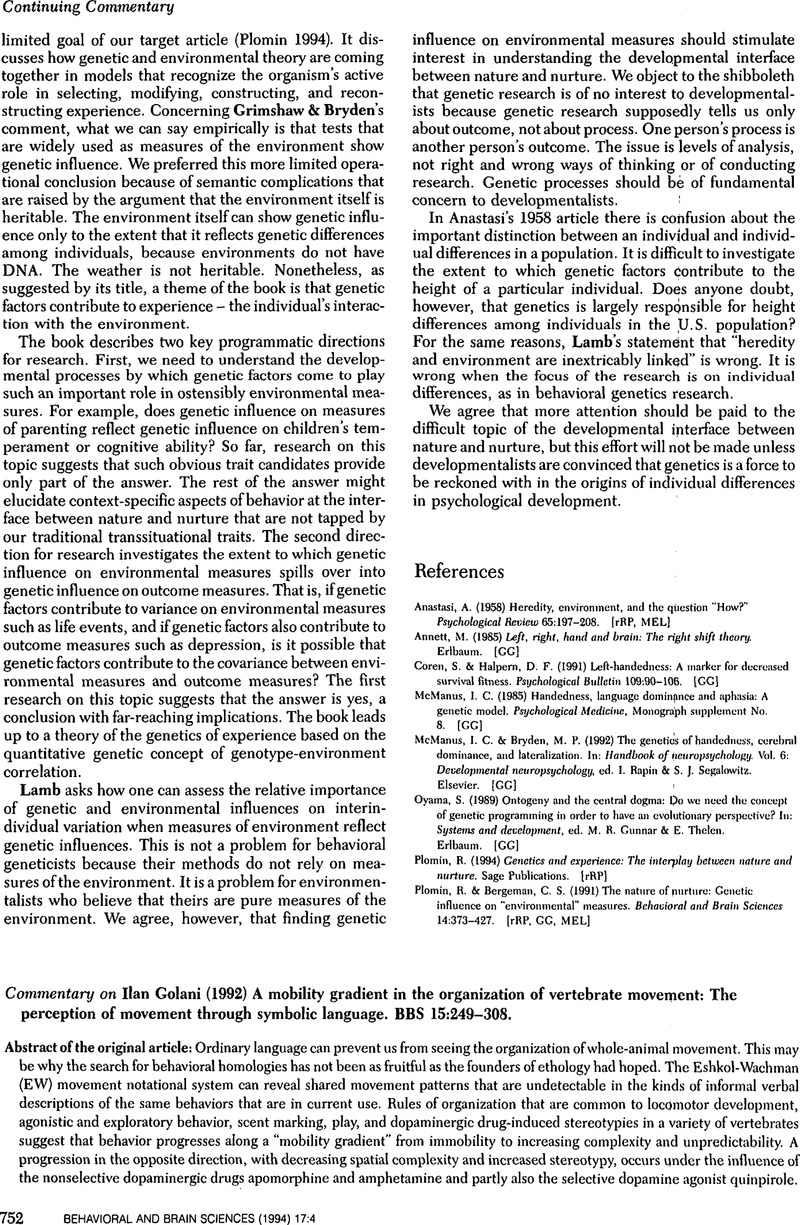No CrossRef data available.
Article contents
Implications of Eshkol-Wachman movement notation for behavioural pharmacology
Published online by Cambridge University Press: 04 February 2010
Abstract
An abstract is not available for this content so a preview has been provided. Please use the Get access link above for information on how to access this content.

- Type
- Article Commentary
- Information
- Copyright
- Copyright © Cambridge University Press 1994
References
Adani, N., Benjamini, Y. & Golani, I. (In preparation) The participation of the parts of the body in horizontal movement in 5mg/kg (+)– amphetaminetreated rats. [rIG]Google Scholar
Adani, N., Kiryati, N. & Golani, I. (1991) The description of rat drug-induced behavior: Kinematics versus response categories. The Neuroscienccs and Bio-Behavioral Reviews, 15:455–60. [rIG]Google Scholar
Allen, C. (1992) Why Eshkol-Wachman behavioral notation is not enough. Behavioral and Brain Sciences 15:266–67. [JKS]Google Scholar
Bekoff, M. (1992) Description and explanation: A plea for plurality. Behavioral and Brain Sciences 15:269–70. [JKS]Google Scholar
Duncan, S. Jr, 1972) Some signals and rules for speaking turns in conversation. Journal of Personality and Social Psychology, 23:283–92. [UH]Google Scholar
Eilam, D. & Golani, I. (1989) Home base behavior of rats (Rattus norvegicus) exploring a novel environment. Behavioral Brain Research 34:199–211. [rIG]Google Scholar
Eilam, D. (1990) Home base behavior in amphetamine-treated tame wild rats (Rattus norvegicus). Behavioral Brain Research 36:161–70. [rIG]Google Scholar
Eilam, D. (1994) Amphetamine-induced stereotypy in rats: Its morphogenesis in locale space from normal exploration. In: Ethology and Pharmacology, ed. Cooper, S. J. & Hendrie, C.. John Wiley & Sons. [rIG]Google Scholar
Einat, C., Tchernichovsky, O. & Golani, I. (Submitted) Midline-plane attraction in the locomotion of normal and dopaminc stimulant-treated rats. Behavioural Pharmacology. [rIG]Google Scholar
Eshkol, N. (1971) The hand book. (Sign language of the deaf). The Movement Notation Society. [rIG]Google Scholar
Golani, I. (1981) The search for invariants in motor behavior. In: Behavioral development, ed. Immelmann, K., Barlow, G. W., Petrinovich, L. & Main, M.. Cambridge University Press. [UH]Google Scholar
Golani, I. (1992) A mobility gradient in the organization of vertebrate movement: The perception of movement through symbolic language. Behavioral and Brain Sciences 15:249–308. [UH, JKS]Google Scholar
Golani, I., Benjamini, Y. & Eilam, D. (1993) Stopping behavior: Constraints on exploration in rats (Rattus norvegicus). Behavioral Brain Research 53:21–33. [rIG]Google Scholar
Grant, E. C. & MacKintosh, J. H. (1963) A comparison of the social postures of some common laboratory rodents. Behaviour 21:246–59. [rIG]Google Scholar
Hadar, U. (1986) Forcefield analogy for communications involving movement of the head: An exercise in ecological semiotics. Sefniotica, 62:279–96. [UH]Google Scholar
Hadar, U. (1989) Two types of gesture and their role in speech production. Journal of Language and Social Psychology, 8:221–28. [UH]Google Scholar
Hadar, U., Steiner, T. J., Grant, E. C. & Clifford Rose, F. (1984) The timing of shifts of head postures during conversation. Human Movement Science, 3:237–45. [UH]Google Scholar
Haken, H. (1983) Synergetics: an introduction. Nonequilibrium phase transitions and self-organization in physics, chemistry, and biology. 3d ed. Springer. [rIG]Google Scholar
Kendon, A. (1972) Some relationships between body motion and speech: An analysis of an example. In: Studies in dyadic communication, ed. Siegman, A. & Pope, B.. Pergamon Press. [UH]Google Scholar
Kendon, A. (1985) Some uses of gesture. In: Perspectives in silence, ed. Taiinen, D. & Saville-Troike, U.. Ablex. [UH]Google Scholar
Mitchell, P. J. & Redfem, P. H. (1992) Acute and chronic antidepressant drug treatments induce opposite effects in the social behaviour of rats. Journal of Psychopharmacology 6:241–57. [rIG, JKS]Google Scholar
Rodgers, R. J., Cole, J. C., Cobain, M. R., Daly, P., Doran, P. J., Eells, J. R. & Wallis, P. (1992) Anxiogenic-like effects of fluprazine and eltoprazine in the mouse elevated plus-maze; profile comparisons with 8-OH-DPAT, CGS12066B, TFMPP and mCPP. Behavioural Pharmacology 3:621–34. [rIG, JKS]Google Scholar
Scheflen, A. (1964) The significance of posture in communication systems. Psychiatry, 27:316–31. [UH]Google Scholar
Shepherd, J. K., Grewal, S. S., Fletcher, A., Bill, D. J. & Dourish, C. T. (1994) Behavioral and pharmacological characterization of the elevated “zero maze” as an animal model of anxiety. Psychopharmacology 116:56–64. [JKS]Google Scholar
Sibley, D. R. & Monsma, F. J. Jr, (1992) Molecular biology of dopamine receptors. Trends in Pharmacological Sciences 13:61–69. [JKS]Google Scholar
Sokoloff, P., Giros, B., Martres, M -P., Bouthenet, M. L. & Schwartz, J. C. (1990) Molecular cloning and characterization of a novel dopamine receptor (D3) as a target for neuroleptics. Nature 347:146–51. [JKS]Google Scholar
Taylor, M., Goudie, A. J., Mortimore, S. & Wheeler, T. J. (1974) Comparison between behaviours elicited by high doses of amphetamine and fenfluramine: Implications on the concept of stereotypy. Psychophamuicology 40:249–58. [JKS]Google Scholar
Tchernichovslcy, O., Benjamini, Y. & Golani, I. (Submitted) The morphogenesis of rat exploratory behavior in locale space. Behavioral Brain Research. [rIG]Google Scholar
Tchernichovsky, O. & Golani, I. (Submitted) A phase plane representation of rat exploratory behavior. Journal of Neurosciencc Methods. [rIG]Google Scholar


